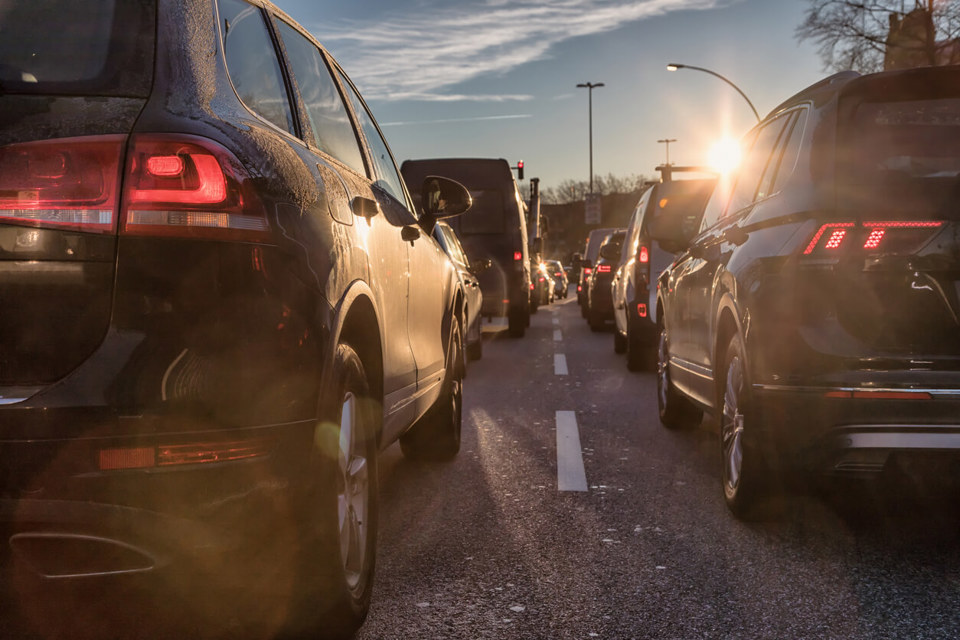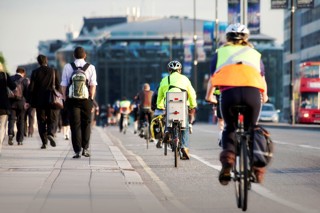City transport systems are being re-imagined for life after lockdown.
Pavements are being widened, pop-up bike lanes created and some roads are being closed to cars and vans altogether.
Social distancing has drastically reduced the capacity of public transport and people are being urged to walk or cycle instead.
Transport secretary Grant Shapps said: “Getting Britain moving again, while not overcrowding our transport network, represents another enormous logistical challenge.”
He has announced a £2 billion package to encourage the much-needed modal shift in transport as people return to work.
An initial £250 million emergency active travel fund will pay for pop-up bike lanes, wider pavements, and cycle- and bus-only corridors in England.
Shapps says that over the next few months, the Government will set out further measures to make a “once in a generation’” change to the way people travel in Britain.
It has also issued local authorities with new statutory guidance telling them to re-allocate road space for significantly increased numbers of cyclists and pedestrians.
AIR QUALITY
Central and local government are keen to build on air quality improvements achieved during lockdown.
New data suggests daily global emissions of CO2 fell by 17% at the peak of the shutdown, because of the measures taken by governments in response to Covid-19.
Lockdown has also seen the most dangerous air quality indicator PM2.5 levels significantly fall in 13 of the UK’s largest cities, with London showing the biggest drop (34%), followed by Leicester (21%) and Edinburgh (17%).
But, without public transport able to take the strain and a reduction in road capacity thanks to new walking and cycling initiatives, could air quality gains be quickly lost?
Shapps said: “One of the few positive benefits about the crisis is drastically better air quality and the health benefits that that brings.
“More than 20,000 extra deaths a year in the UK are attributed to nitrogen dioxide emissions, which are highest in areas with most road traffic.
“We want to try to preserve this (improvement) as much as possible.”
ROADS CLOSED
The Mayor of London, Sadiq Khan, has said some streets in the capital will be converted to walking and cycling only, with others restricted to all traffic apart from buses.
The ‘Streetspace’ measures include a plan for streets between London Bridge and Shoreditch, Euston and Waterloo, and Old Street and Holborn to be limited to buses, pedestrians and cyclists.
Access for emergency services and disabled people will be maintained, but Khan says deliveries on some streets may need to be made outside congestion charging hours.
Waterloo Bridge and London Bridge may also be restricted to people walking, cycling and buses only, with pavements widened.
Euston Road is one of the first main thoroughfares in the capital to have temporary cycle lanes introduced. Park Lane could follow suit.
Pavements are also being widened in more than 20 locations, including in Brixton and Earl’s Court, with more to follow in the coming weeks.
Khan said: “These plans will transform parts of central London to create one of the largest car-free areas in any capital city in the world.”
LESS CONGESTION
Greater Manchester local authorities, meanwhile, have launched the ‘Safe Streets Save Lives’ campaign to support social distancing during coronavirus lockdown and recovery.
They are prioritising a range of temporary, pop-up measures such as footway extensions, one-way streets, removing through traffic on certain roads and adding extra cycle lanes.
The changes are being paid for from £5m of funding made available through the mayor’s Cycling and Walking Challenge Fund.
Traffic volumes have fallen by about 60% across Greater Manchester, with walking and cycling playing an increasingly important role.
They now account for approximately 33% of all journeys, with cycling up 22% compared with pre-lockdown data.
Andy Burnham, Mayor of Greater Manchester, said: “Whatever people’s motivation, these choices are contributing to cleaning up our city’s air and causing less congestion on our roads, and that’s something we must sustain for the immediate future.”
However, as schemes are fast-tracked in towns and cities across the country, with little opportunity for consultation, fears are mounting that fleet operations could be severely hampered (see page 76).
‘GRIDLOCKED’ CITIES
Deliveries have been highlighted as a major concern, but congestion could pose a further headache for fleets; exacerbated by a reduction in road space and the potential for commuters to choose the car over cycling or walking as an alternative to public transport.
The AA president Edmund King says there could be an increase in car use in cities where people “shun public transport for fear of the virus”.
A recent survey by Ipsos Mori found that more than three-in-five (61%) of people polled in early May are concerned about using public transport due to the perceived infection risk.
Meanwhile, nine-out-of-10 respondents to a Smart Transport survey believe fewer people will use public transport over the next few years.
In Wuhan, China, private car usage nearly doubled when lockdown ended, rising from 34% before the outbreak to 66% after lockdown.
Shapps acknowledged that, with public transport capacity severely restricted, “more cars could be drawn to the road” and towns and cities could become “gridlocked”.
LOW CARBON
Paul Jones, chair of the automobile division at the Institution of Mechanical Engineers (IMechE), says if the car becomes the transport choice for people returning to work in the UK, then a switch to lower carbon fuels such as E10 petrol and biodiesel should be considered.
Jones claims this could “very quickly help to offset any potential CO2 increase”.
By increasing the ethanol content of petrol to 10%, E10 has the potential to cut CO2 from transport by 750,000 tonnes per year. That’s the equivalent to taking about 350,000 cars off the road, Government figures suggest.
IMechE launched a consultation in March on E10 petrol becoming standard at UK filling stations from next year.
Current petrol grades in the UK already contain up to 5% bioethanol, known as E5. E10 would see this percentage increased up to 10%. This is a blend which is already well used in other countries such as Belgium, Finland, France and Germany.
Jones said: “Placing a new focus on how greater use of biofuels and e-fuels could be increased in our transport energy mix will provide a bridge between our current technologies and infrastructures and those we expect to see in 10 years’ time.”
HOMEWORKING
Further respite might be provided by those staff working from home during the lockdown, continuing to do so in the future.
A survey by The AA showed two thirds (66%) of respondents were working from home, while one third (34%) were unable to do so.
One-in-10 said they would work from home more often once the lockdown is lifted, with this increasing to 23% among those aged 35-44.
Such changes in working patterns could help balance the switch away from public transport, but also force fleets to re-think policies, in terms of the number of type of vehicles they operate.
Neil King, senior data journalist at Autovista Group, said: “The pandemic has been a major driver of digitalisation and increased working from home.
“Many companies that previously resisted allowing employees to work from home have changed their position, albeit often through necessity.”
Looking forward, he says a change in working patterns is “certain” and may influence fleet purchases as employees commute less and salespeople participate in more online meetings and conduct fewer in person, reducing mileage rates and changing vehicle needs.
Fleet News is again conducting a survey of fleet decision-makers as lockdown measures are lifted, please read more here.























Edward Handley - 10/06/2020 11:27
There is a serious lack of joined up thinking here: The biggest cause of traffic pollution is congestion - vehicles ticking over for long periods and working inefficiently in stop-start traffic emit way more pollutants, but all the measures being planned will increase congestion when things pick up - as they must and will - particularly if there is a shift away from public transport to private cars. Banning delivery vehicles during peak hours sounds a good idea but in practice is almost impossible to achieve, particularly for London and the other metropolises where getting in and out alone takes hours, to say nothing of the problems for tradesmen using their cars and vans as mobile tool boxes. Without technicians and tradesmen things stop working! If government are serious about improving air quality in city centres they need to tackle congestion, and although it is politically incorrect to say it, that means building new roads. There has been a massive increase in house building across the UK, with a few new roads, but no where near enough to upgrade the road system to cope with the increase in population. Increased walking and cycling are fine for short journeys but most of the new houses are a long way from people's jobs, and when you need to carry heavy tools, equipment and spare parts, or indeed bags of shopping, you need a car or van.